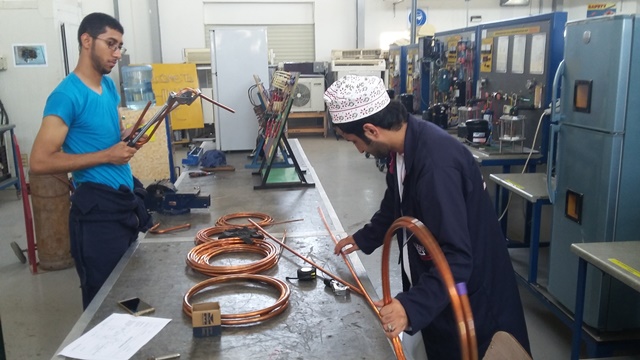 |
| Working with copper tubes: Sultan (right) and Saeed (left) in action during their RAC Training at Shinas VTC (06/2016) |
One of the skills that must be mastered in the study of Refrigeration and Air Conditioning is working with copper tube, also known as "tube processing." Most of the Refrigeration and Air Conditioning units are using copper tube as connecting coil where the refrigerant flows as it absorbs and extracts heat.
Though, aside from copper, aluminum, stainless and steel tubes are also used in some special application. For example, aluminum tubes are used in many evaporator coils in most of domestic and commercial refrigeration units since aluminum material is rust free. When ice is formed around the evaporator coil, anytime of the day it may melt and turn into liquid or water, especially during the compressor off cycle or during the defrost mode. To keep the evaporator stand against any possible structural damage due to corrosion, aluminum tube is used.
For all beginners in the trade, it is very much important to acquire basic skills in working with copper tubes. These skills involve cutting of cupper tubes, flaring and swaging of copper tube ends, making flared connection or flare fittings, copper tube bending and lastly, copper tube brazing using oxy-acetylene gas or disposable portable mapp gas.
During the training, students will acquire skills on how to use common tools as well as those special tools in refrigeration designed only for the above mentioned tasks. These are the tube cutter, tube reamer, files, flaring tool, swaging tool, tube bender, adjustable wrenches and the proper way of operating oxy-acetylene gas welding equipment. Basically,skills will only be acquired when a person involved or a technician knows how to use tools designed for that certain job.
Proper way of operating oxy-acetylene welding equipment involves how to open oxygen and acetylene cylinders, what is the tool that must be used, how to open oxygen and acetylene regulator, how to light the torch and how to mix oxygen and acetylene gas to come up with right kind of flame for brazing copper tubes and the right practice in applying the flame using silver rod.
Working with copper tube also requires familiarization of copper tube sizes, which is according to tube diameter. The most common available sizes in the field are 5/8, 1/2, 3/8,5/16, 1/4, 3/16 and the smallest copper tube used as refrigerant control called capillary tube. All of the above sizes are in English system or in "inches." To have a little background on how to do the above mentioned tasks, let us now discuss in brief each of the basic steps for each skills.
Cutting of Copper Tube
Cutting of tube could be done by any cutting tools but never the tube used in refrigeration and air conditioning. This might be an exaggeration but considering the sensitivity of this field, right tools must be used always to perform the right job. Refrigeration technicians or mechanics who have poor understanding usually the ones who perform poor practice in cutting of tubes. He may use hacksaw for this job just for the purpose of cutting, which is completely unacceptable.
To cut a copper tube, a special tool called tube cutter must be used. This tool has a roller and roller blade which holds and cut the tube as it revolves around the outside diameter. When cutting, just place the tube between the roller and roller blade, tight it using the adjuster at the other end, rotate the tube cutter in clockwise direction for one cycle, and tight. One tight and one round till you feel that the grip losses, it means the outside surface of the tube is now sliced. Repeat the process till the tube is cut.
Flaring of Copper Tube
Flaring is basically preparing copper tube end for making a flared connection. Flared connection is a method used in refrigeration to connect two tubes using flare union and flare nut. It is simply expanding the copper tube end so that flare nut will not slip through the tube. Therefore, making a grip between the flare nut against flare union when tightened.
However, one of the right practices in refrigeration is to eliminate as much as possible any flared connections. In most cases, refrigerant leak occurs on spots where there is flared connection. So to get rid of any leak possibility, it is advised to avoid any flared connection as much as possible. Use it only when highly required, or when brazing upon joining of tubes is not possible. The best practice though is to use copper tubes in any system without joints.
But as a beginner, we have to know some basic ideas and skills on how to do flaring of copper tube in a right way. Like other tasks, it can only be done using a tool used only for this purpose, called "flaring tools."
When we say flaring tools, there are two tools involved. These are the flaring block and flaring yoke. The first holds the copper tube and the other one expands the tube ends. Flaring is done by applying a gradual pressure on the inner diameter of the tube end using the tapered end of the flaring yoke. It can be done by manually tightening the flaring yoke against the flaring block with the copper tube and the yoke touching each other at the middle.
The following video may also help you to know how to flare copper tube in refrigeration and air conditioning application.
Note: Flaring nut must be inserted first to the tube before doing the flare unless the opposite end of the tube is open to accommodate the flaring nut.
<


